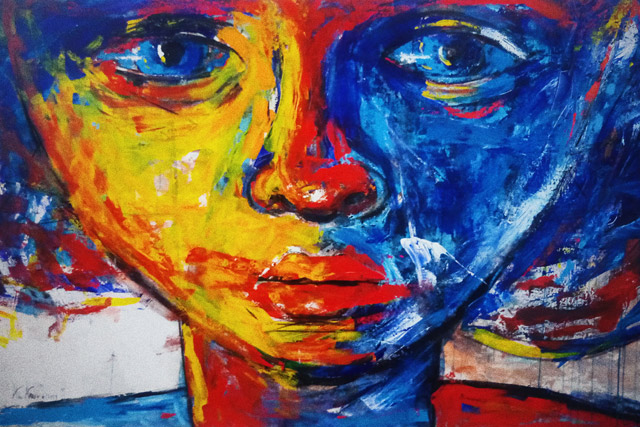AMMAN — A new art show titled ‘Spago Art Gallery’ is showcasing the work of both established and emerging European artists, with a focus on contemporary art.
Held in the Spago Restaurant in Amman’s Sweifieh neigbourhood, the exhibition, brings to Jordan the talent of artists such as Georg Brandner (Austria), Maria Balea (Romania), Witold Stypa (Germany), Nora Blaj (Romania), Adi Atassi (Cyprus), Katerina Katsifaraki (Greece), Ajtai Tamas (Hungary) and Zhyldyz Oruzbaeva (Uzbekistan).
A 1.69-metre-tall acrylic on wood directly attracts the attention of the visitor on the second floor of the gallery. It is “Green Face”, one of the latest works of the Cyprus-based artist Adi Atassi.
Atassi was born in Syria in 1962 and his childhood in Homs has influenced his artwork with the beauty of the Syrian landscape, which the artist conveys with mosaics and strong light and shadow effects.
The artist moved to Cyprus in 1987, initiating a transition in the style of his paintings. While his earliest works showcase realistic representations of the world, Atassi’s latest paintings dig in deeper ideas, aiming at the understanding of the “divine” within us.
“My deeper self is always seeking to find harmony and communication in between the visible and invisible souls of the things around us, transforming it by manipulation, experimentation on the laboratory of my brain and heart to become a wave of creativity,” the artist said.
While Atassi’s work explores the inner world, Witold Stypa aims to create a sensibility for the new, stimulating the human imagination by leading the observer to the visualisation of a “multidimensional process”.
A different concept is found in the work of Ajtai Tamas, who mixes painted panels with ceramic designs influenced by synthetic cubism, abstract expressionism, and the decorative nature of Art Nouveau.
For her part, Oruzbaeva sees her own art as a method of psychotherapy used to treat medical and psychological problems. “Today, many people are in need of psychological help. If my paintings can help those people a little bit to get out of difficult situations, then that means that I do not live in vain,” she stated.
Art is also seen as a beneficial tool by Nora Blaj, who explains that, in her paintings, she tries to keep “the permanent connection between the things and their patterns, so I can gradually watch and dream about the same reality where you need a lot of silence and stillness in order to obtain a balance between yourself and your surroundings”.
The creations of Romanian artist Maria Balea work as a series of memory slides, with different engraving pieces alternated with insertions of collage, signs and letters.
Similarly, Austrian artist Georg Brandner creates tangible works that integrate experiences, impressions and feelings from his multiple travels through the use of materials such as jute, corrugated cardboard, quartz sand, card paper and silk cloths.
His latest works also introduce interesting structures thanks to the incorporation of painting techniques such as sprinkling or smudging.
Katerina Katsifaraki is the Greek addition to this exhibit, with a long trajectory on abstract art that lets the observers make their own interpretations.
Born in Athens, Katsifaraki has been a member of The Greek Fine Arts Chambre since 1998 and is also an arts professor at the Hellenic American Educational Foundation.
The exhibition will run until August 24.
